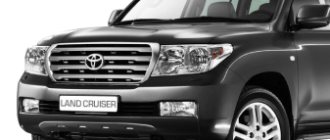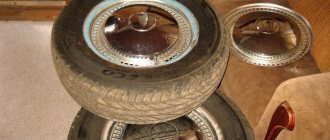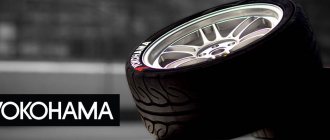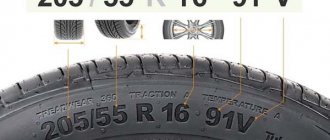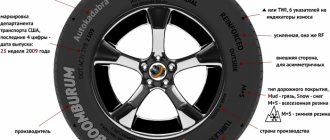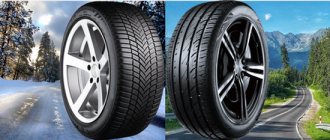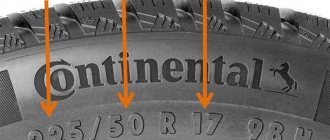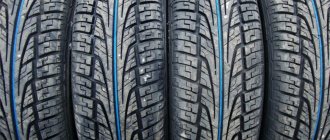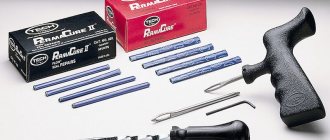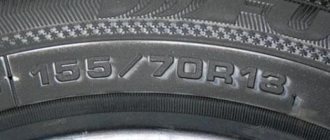A lot depends on the right choice of shoes for your car. When deciding to purchase a kit, you can be guided by various comparative tests. However, it is worth remembering that their characteristics must correspond to operating conditions. In this case, the information indicated in the markings on the sidewall of the tire will help. Such inscriptions on the tire indicate the size of the product and its technological characteristics. Below we will decipher the symbols and try to figure out what the numbers and letters in the rubber markings mean.
How to decipher tire markings?
The choice of car tires is always a crucial moment in the life of every motorist. But to independently select the right car tires, you need to know the design features and understand the main markings that are applied to each car tire.
The following combinations of designations of the main parameters are accepted on all car tires:
P 185/65 R14 86 N
- P – designation of the type of vehicle for which these tires are intended. “P or Passanger” - passenger car, “LT or Light Truck” - light truck, etc.
P 185/65 R14 86 N
- 185 – value of the tire profile width, mm.
- 65 – the value of the tire profile height, measured as a percentage of the width. If a standard size without height is specified, for example 175 R13, the height is assumed to be 80-82% (full-profile tires).
- R – tire design, divided into radial (R) and diagonal (D). The radial design is characterized by a parallel arrangement of rubberized cord threads, the diagonal design is characterized by an overlapping arrangement of threads.
- 14 – distance between the inner edges of the tire i.e. its internal diameter is calculated in inches.
- 86 – coefficient or load index. Indicates the permissible load per tire in kg.
| Load Index | 60 | 61 | 62 | 63 | 64 | 65 | 66 | 67 | 68 | 69 |
| Max. Load (in kg.) | 250 | 257 | 265 | 272 | 280 | 290 | 300 | 307 | 315 | 325 |
| Load Index | 70 | 71 | 72 | 73 | 74 | 75 | 76 | 77 | 78 | 79 |
| Max. Load (in kg.) | 335 | 345 | 355 | 365 | 375 | 387 | 400 | 412 | 426 | 437 |
| Load Index | 80 | 81 | 82 | 83 | 84 | 85 | 86 | 87 | 88 | 89 |
| Max. Load (in kg.) | 450 | 462 | 475 | 487 | 500 | 515 | 530 | 545 | 560 | 580 |
| Load Index | 90 | 91 | 92 | 93 | 94 | 95 | 96 | 97 | 98 | 99 |
| Max. Load (in kg.) | 600 | 615 | 630 | 650 | 670 | 690 | 710 | 730 | 750 | 775 |
| Load Index | 100 | 101 | 102 | 103 | 104 | 105 | 106 | 107 | 108 | 109 |
| Max. Load (in kg.) | 800 | 825 | 850 | 875 | 900 | 925 | 950 | 975 | 1000 | 1030 |
| Load Index | 110 | 111 | 112 | 113 | 114 | 115 | 116 | 117 | 118 | 119 |
| Max. Load (in kg.) | 1060 | 1090 | 1120 | 1150 | 1180 | 1215 | 1250 | 1285 | 1320 | 1360 |
| Load Index | 120 | 121 | 122 | 123 | 124 | 125 | 126 | 127 | 128 | 129 |
| Max. Load (in kg.) | 1400 | 1450 | 1500 | 1550 | 1600 | 1650 | 1700 | 1750 | 1800 | 1850 |
- H – speed coefficient or index. Indicates the value of the maximum permissible speed at which safe movement is possible.
| Speed index | J | K | L | M | N | P | Q | R | S | T | U | H | V | VR | W | Y | ZR |
| Max. Speed (km/h) | 100 | 110 | 120 | 130 | 140 | 150 | 160 | 170 | 180 | 190 | 200 | 210 | 240 | >210 | 270 | 300 | >240 |
Indices of permissible load and speeds
Load index (LOI) - designation by numbers of the permissible load on a tire in kilograms. The value ranges from 0 (45 kg) to 279 (136,000 kg). You can find out in detail which index is in the table below:
| ANN | MAX, kg | ANN | MAX, kg | ANN | MAX, kg | ANN | MAX, kg | ANN | MAX, kg | ANN | MAX, kg | ANN | MAX, kg |
| 0 | 45 | 40 | 140 | 80 | 450 | 120 | 1400 | 160 | 4500 | 200 | 14000 | 240 | 45000 |
| 1 | 46,2 | 41 | 145 | 81 | 462 | 121 | 1450 | 161 | 4625 | 201 | 14500 | 241 | 46250 |
| 2 | 47,5 | 42 | 150 | 82 | 475 | 122 | 1500 | 162 | 4750 | 202 | 15000 | 242 | 47500 |
| 3 | 48,7 | 43 | 155 | 83 | 487 | 123 | 1550 | 163 | 4875 | 203 | 15500 | 243 | 48750 |
| 4 | 50 | 44 | 160 | 84 | 500 | 124 | 1600 | 164 | 5000 | 204 | 16000 | 244 | 50000 |
| 5 | 51,5 | 45 | 165 | 85 | 515 | 125 | 1650 | 165 | 5150 | 205 | 16500 | 245 | 51500 |
| 6 | 53 | 46 | 170 | 86 | 530 | 126 | 1700 | 166 | 5300 | 206 | 17000 | 246 | 53000 |
| 7 | 54,5 | 47 | 175 | 87 | 545 | 127 | 1750 | 167 | 5450 | 207 | 17500 | 247 | 54500 |
| 8 | 56 | 48 | 180 | 88 | 560 | 128 | 1800 | 168 | 5600 | 208 | 18000 | 248 | 56000 |
| 9 | 58 | 49 | 185 | 89 | 580 | 129 | 1850 | 169 | 5800 | 209 | 18500 | 249 | 58000 |
| 10 | 60 | 50 | 190 | 90 | 600 | 130 | 1900 | 170 | 6000 | 210 | 19000 | 250 | 60000 |
| 11 | 61,5 | 51 | 195 | 91 | 615 | 131 | 1950 | 171 | 6150 | 211 | 19500 | 251 | 61500 |
| 12 | 63 | 52 | 200 | 92 | 630 | 132 | 2000 | 172 | 6300 | 212 | 20000 | 252 | 63000 |
| 13 | 65 | 53 | 206 | 93 | 650 | 133 | 2060 | 173 | 6500 | 213 | 20600 | 253 | 65000 |
| 14 | 67 | 54 | 212 | 94 | 670 | 134 | 2120 | 174 | 6700 | 214 | 21200 | 254 | 67000 |
| 15 | 69 | 55 | 218 | 95 | 690 | 135 | 2180 | 175 | 6900 | 215 | 21800 | 255 | 69000 |
| 16 | 71 | 56 | 224 | 96 | 710 | 136 | 2240 | 176 | 7100 | 216 | 22400 | 256 | 71000 |
| 17 | 73 | 57 | 230 | 97 | 730 | 137 | 2300 | 177 | 7300 | 217 | 23000 | 257 | 73000 |
| 18 | 75 | 58 | 236 | 98 | 750 | 138 | 2360 | 178 | 7500 | 218 | 23600 | 258 | 75000 |
| 19 | 77,5 | 59 | 243 | 99 | 775 | 139 | 2430 | 179 | 7750 | 219 | 24300 | 259 | 77500 |
| 20 | 80 | 60 | 250 | 100 | 800 | 140 | 2500 | 180 | 8000 | 220 | 25000 | 260 | 80000 |
| 21 | 82,5 | 61 | 257 | 101 | 825 | 141 | 2575 | 181 | 8250 | 221 | 25750 | 261 | 82500 |
| 22 | 86 | 62 | 265 | 102 | 850 | 142 | 2650 | 182 | 8500 | 222 | 26500 | 262 | 85000 |
| 23 | 87,5 | 63 | 272 | 103 | 875 | 143 | 2725 | 183 | 8750 | 223 | 27250 | 263 | 87500 |
| 24 | 90 | 64 | 280 | 104 | 900 | 144 | 2800 | 184 | 9000 | 224 | 28000 | 264 | 90000 |
| 25 | 92,5 | 65 | 290 | 105 | 925 | 145 | 2900 | 185 | 9250 | 225 | 29000 | 265 | 92500 |
| 26 | 95 | 66 | 300 | 106 | 950 | 146 | 3000 | 186 | 9500 | 226 | 30000 | 266 | 97500 |
| 27 | 97,5 | 67 | 307 | 107 | 975 | 147 | 3075 | 187 | 9750 | 227 | 30750 | 267 | 97500 |
| 28 | 100 | 68 | 315 | 108 | 1000 | 148 | 3150 | 188 | 10000 | 228 | 31500 | 268 | 100000 |
| 29 | 103 | 69 | 325 | 109 | 1030 | 149 | 3250 | 189 | 10300 | 229 | 32500 | 269 | 103000 |
| 30 | 106 | 70 | 335 | 110 | 1060 | 150 | 3350 | 190 | 10600 | 230 | 33500 | 270 | 106000 |
| 31 | 109 | 71 | 345 | 111 | 1090 | 151 | 3450 | 191 | 10900 | 231 | 34500 | 271 | 109000 |
| 32 | 112 | 72 | 355 | 112 | 1120 | 152 | 3550 | 192 | 11200 | 232 | 35500 | 272 | 112000 |
| 33 | 115 | 73 | 365 | 113 | 1150 | 153 | 3650 | 193 | 11500 | 233 | 36500 | 273 | 115000 |
| 34 | 118 | 74 | 375 | 114 | 1180 | 154 | 3750 | 194 | 11800 | 234 | 37500 | 274 | 118000 |
| 35 | 121 | 75 | 387 | 115 | 1215 | 155 | 3875 | 195 | 12150 | 235 | 38750 | 275 | 121000 |
| 36 | 125 | 76 | 400 | 116 | 1250 | 156 | 4000 | 196 | 12500 | 236 | 40000 | 276 | 125000 |
| 37 | 128 | 77 | 412 | 117 | 1285 | 157 | 4125 | 197 | 12850 | 237 | 41250 | 277 | 128500 |
| 38 | 132 | 78 | 426 | 118 | 1320 | 158 | 4250 | 198 | 13200 | 238 | 42500 | 278 | 132000 |
| 39 | 136 | 79 | 437 | 119 | 1360 | 159 | 4375 | 199 | 13600 | 239 | 43750 | 279 | 136000 |
Tires intended for the North American market are also embossed with the “Maximum Pressure” , which is measured in pounds per square inch (1 PSI = 0.068046 Atmospheres) and “Maximum Load” , in pounds or kilograms. Max. press. means the maximum permissible pressure in cold tires, and Max. load - load.
The speed index is an indicator of the maximum permissible speed to which tires can accelerate. The value is indicated in Latin letters from A to Z and, accordingly, the speed limit is 5-300 km/h (there is no marking above 300 km/h).
| Index | M/h | km/h | Index | M/h | km/h |
| A1 | 3 | 5 | L | 75 | 120 |
| A2 | 6 | 10 | M | 81 | 130 |
| A3 | 9 | 15 | N | 87 | 140 |
| A4 | 12 | 20 | P | 94 | 150 |
| A5 | 16 | 25 | Q | 100 | 160 |
| A6 | 19 | 30 | R | 106 | 170 |
| A7 | 22 | 35 | S | 112 | 180 |
| A8 | 25 | 40 | T | 118 | 190 |
| B | 31 | 50 | U | 124 | 200 |
| C | 37 | 60 | H | 130 | 210 |
| D | 40 | 65 | V | 149 | 240 |
| E | 43 | 70 | Z/ZR | over 149 | over 240 |
| F | 50 | 80 | W | 168 | 270 |
| G | 56 | 90 | (W) | over 168 | over 270 |
| J | 62 | 100 | Y | 186 | 300 |
| K | 68 | 110 | (Y) | over 186 | over 300 |
Read more about tire indexes at the link.
Extra options:
Extra Load (XL)
– reinforced model, the load index of such tires is 3 units higher in comparison with simple tires of the same size.
Reinforced (C)
– designation of high-strength tires, most often refers to light truck models.
All Season (AS), Тous terrain
– all-season tires.
Any weather (AW)
– all-weather tires. Often, instead of letter symbols, icons are used (snowflake, cloud, sun, etc.).
Mudd & Snow (M&S)
– tires specially designed for both winter and all-season use.
D.A.
(Stamp) – designation of tires with minor manufacturing defects that do not interfere with safe operation.
DOT
- Approved by the US Department of Transportation.
E
– approved by the Economic Commission for Europe.
Inside
– designation of asymmetric tires. When installed, the inscription Inside must be on the inside of the vehicle.
Outside
– designation of asymmetric tires. When installed, the word Outside must be on the outside of the vehicle.
Left
– tires with this marking should be installed only on the left side.
Right
– tires with this marking must be installed only on the right side.
Made in Germany
– designation of the country of origin.
Max Pressure
– maximum permissible tire pressure, in kPa.
PSI
– Pressure index from 20 to 85 (only for tires with the index “C”).
Aqua, Aquatred, Rain, Aquacontact, Water, or umbrella icon
– means that the tires are designed for rainy weather and effectively prevent the occurrence of aquaplaning.
Regroovable
– indicated if it is possible to deepen the tread pattern by cutting.
Retread
– retreaded tires.
Rotation
– directional tires, the direction of rotation is indicated by an arrow on the sidewall of the tire.
Steel
– means that the tires are equipped with a metal cord.
Temperature
– temperature conditions provided for a specific model, there are three categories: A, B and C.
Treadwear, TWI
– coefficient or wear resistance index, determined in relation to the “base tire”, for which it is equal to 100.
Traction
– the adhesion coefficient, like the temperature regime, is divided into 3 categories: A, B and C. Coefficient A has the greatest value.
Tread
– indicates that the tire consists of 5 layers: a layer of artificial silk + 2 layers of steel cord + 2 layers of nylon. Applicable in the USA.
Tubeless (TL)
– designation of tubeless tires. If this marking is missing, the tire can only be used with a tube.
Tube Type (TT)
– operation is possible only with a camera.
Source
Tire markings
Do you want to choose a tire for your car, but are not well versed in tire labeling? It's not a problem! In this section, we will help you figure out what tire parameters are, what they mean, and which tire is suitable for your car.
Decoding tire markings.
195/65 R15 91 T XL
195 is the width of the tire in mm.
65 - Proportionality, i.e. ratio of profile height to width. In our case it is 65%. Simply put, with the same width, the larger this indicator, the higher the tire will be and vice versa. Usually this value is simply called “profile”.
Since the tire profile is a relative value, it is important to take into account when selecting tires that if instead of size 195/65 R15 you want to install tires with size 205/65 R15, then not only the width of the tire will increase, but also the height! Which is unacceptable in most cases! (except for cases when both of these standard sizes are indicated in the car’s operating book). You can calculate exact data on changes in external wheel dimensions in a special tire calculator.
If this ratio is not specified (for example, 185/R14C), then it is equal to 80-82% and the tire is called full-profile. Reinforced tires with this marking are usually used on minibuses and light trucks, where a large maximum load on the wheel is very important.
R stands for radial tire (in fact, almost all tires are made this way now).
Many people mistakenly believe that R- means radius of the tire, but this is precisely the radial design of the tire. There is also a diagonal design (denoted by the letter D), but recently it has practically not been produced, since its performance characteristics are noticeably worse.
15 — wheel (disk) diameter in inches. (It’s the diameter, not the radius! This is also a common mistake). This is the “fitting” diameter of the tire on the disk, i.e. This is the inner size of the tire or the outer size of the rim.
91 — load index. This is the level of maximum permissible load on one wheel. For passenger cars, it is usually done with a reserve and is not a decisive factor when choosing tires (in our case, ID - 91 - 670 kg). For minibuses and small trucks, this parameter is very important and must be observed.
Tire load index table:
T is the tire speed index. The larger it is, the higher the speed you can drive on a given tire (in our case IS - N - up to 210 km/h). Speaking about the tire speed index, I would like to note that with this parameter the tire manufacturer guarantees normal operation of the tire when the car is constantly moving at the specified speed for several hours.
Speed index table:
American tire markings:
There are two different markings for American tires. The first is very similar to the European one, only the letters “P” (Passanger - for a passenger car) or “LT” (Light Truck) are placed in front of the standard size. For example: P 195/60 R 14 or LT 235/75 R15. And another tire marking, which is fundamentally different from the European one.
For example: 31×10.5 R15 (corresponds to European standard size 265/75 R15)
31 is the outer diameter of the tire in inches. 10.5 - tire width in inches. R is a radial tire (older tire models had a diagonal design). 15 is the inner diameter of the tire in inches.
Generally speaking, apart from the unusual inches for us, the American tire markings are logical and more understandable, unlike the European ones, where the tire profile height is not constant and depends on the width of the tire. And here everything is simple with decoding: the first number of the standard size is the outer diameter, the second is the width, the third is the inner diameter.
Additional information indicated in the markings on the sidewall of the tire:
XL or Extra Load is a reinforced tire, the load index of which is 3 units higher than that of conventional tires of the same size. In other words, if a given tire has a load index of 91 marked XL or Extra Load, this means that with this index, the tire can withstand a maximum load of 670 kg instead of 615 kg (see table of tire load indexes).
M+S or tire marking M&S (Mud + Snow) - mud plus snow and means that the tires are all-season or winter. Many summer SUV tires will say M&S on them. However, these tires cannot be used in winter, because... winter tires have a completely different rubber composition and tread pattern, and the M&S badge indicates good cross-country ability of the tire.
All Season or AS all-season tires. Aw (Any Weather) - Any weather.
Pictogram * (snowflake) - tires are intended for use in harsh winter conditions. If there is no this marking on the sidewall of the tire, then this tire is intended for use only in summer conditions.
Aquatred, Aquacontact, Rain, Water, Aqua or pictogram (umbrella) are special rain tires.
Outside and Inside ; asymmetrical tires, i.e. It is important not to confuse which side is external and which internal. When installing, the inscription Outside should be on the outside of the car, and Inside should be on the inside.
RSC (RunFlat System Component) - RunFlat tires are tires on which you can continue driving a car at a speed of no more than 80 km/h with a COMPLETE loss of pressure in the tire (due to a puncture or cut). On these tires, depending on the manufacturer's recommendations, you can drive from 50 to 150 km. Different tire manufacturers use different designations for RSC technology. For example: Bridgestone RFT, Continental SSR, Goodyear RunOnFlat, Nokian Run Flat, Michelin ZP, etc.
Rotation or arrow, this marking on the sidewall of the tire indicates a directional tire. When installing a tire, you must strictly observe the direction of rotation of the wheel indicated by the arrow.
Tubeless is a tubeless tire. If this inscription is missing, the tire can only be used with a tube. Tube Type - means that this tire must be used only with a tube.
Max Pressure ; maximum permissible tire pressure. Max Load - maximum permissible load on each vehicle wheel, in kg.
Reinforced or the letters RF in the size (for example 195/70 R15RF) mean that this is a reinforced tire (6 layers). The letter C at the end of the size (for example 195/70 R15C) indicates a truck tire (8 plies).
Radial - this marking on the tire in the standard size means that it is a tire of radial design. Steel means that the tire has a metal cord in its construction.
Letter E (circled) - the tire meets the European requirements of ECE (Economic Commission for Europe). DOT (Department of Transportation - US Department of Transportation) - American quality standard.
Temperature A, B or C is the heat resistance of tires at high speeds on a test bench (A is the best indicator).
Traction A, B or C - the tire's ability to brake on a wet road surface.
Treadwear ; relative expected mileage compared to a specific US standard test.
TWI (Tread Wear Indiration) - indicators of tire tread wear indicators. The marking on the TWI wheel may also include an arrow. The indicators are located evenly in eight or six places around the entire circumference of the tire and indicate the minimum permissible tread depth. The wear indicator is made in the form of a protrusion with a height of 1.6 mm (the minimum tread size for light cars) and is located in the tread recess (usually in the drainage grooves).
DOT - Manufacturer's encoded address, tire size code, certificate, date of manufacture (week/year).
Source
Deciphering permanent inscriptions
As a rule, there are several standard designations on a tire that are common to all companies.
Brand, model, logo
On each tire, the manufacturer indicates the name of the company, brand of tire, as well as some other inscriptions.
Tire sizes
In all cases, the tire contains numbers indicating the tire size. They may differ on European and American products. You have already read above about how to decipher these inscriptions. The most interesting thing is that if you get used to the inch measurement system, the American method is more understandable. After all, with the same profile height, different tires may have different actual performance due to the width of the rubber.
Speed index
Each tire has a mandatory letter marking, indicating what maximum speed can be achieved on these tires. The closer the letter is to the end of the alphabet, the higher this indicator. If the letter S or T is indicated on the sidewall, then on such a tire you can reach a speed of 180 or 190 km/h. The symbols U, H or V indicate a maximum of 200, 210 and 240 km/h respectively. There are super-fast Potenza models that can withstand the load at speeds of 270-300 km/h. Such tires have a W or Y value.
Load Index
On all brands of tires, next to the speed indicator there is a number indicating the maximum load index. The higher this indicator, the more weight the wheel carries.
Information table
| Index | Load, kg |
| 60-70 | 250-335 |
| 71-80 | 345-450 |
| 81-90 | 462-600 |
| 91-100 | 615-800 |
| 101-110 | 825-1060 |
| 111-120 | 1090-1400 |
| 121-130 | 1450-1850 |
If the wheel is marked EL (Extra Load), then the load index becomes three units higher. This indicates a reinforced sidewall and wheel cord. These tires are used by light trucks or as a spare tire for heavy vehicles.
It is worth adding that this indicator is calculated at the maximum permissible pressure. Otherwise, if there is a significant load, the rubber may become deformed and fly off the rim of the disc. Therefore, under heavy loads, you should carefully monitor the tire pressure. You can find out what pressure your tires should be by looking at the Max Pressure index printed near the inner cord.
Decoding tire markings: all the subtleties
When you decide to buy new tires for your car, when choosing in a store, you will certainly be faced with the fact that there will be a lot of letters and numbers on them that are difficult for an inexperienced person to understand. Which ones are the most important and what do they mean? Let's understand the decoding of the notation.
- 2 Designation of sizes and their interpretation
- 3 Load capacity index
- 4 Speed + table by meaning of letters
- 5 Wear resistance
- 6 Temperature quality index
- 7 Grip qualities
- 8 Maximum pressure parameter
- 9 Purpose, seasonality
- 10 Date of manufacture
- 11 Designation of tube/tubeless tires
- 12 Car tire certification index
- 13 Rotation direction sign or outside tire sign
- 14 Additional indexes
Do you know what the numbers on the sidewall of your tire actually mean?
03.06.2015
For many people who own a car, the tire size designation is the same as a set of Chinese characters. By the way, the ability to determine the tire size can play into your hands in many situations. Also, knowing the meaning of the numbers and the principles of marking, you can install larger or smaller tires without damage to the car. But not all at once.
What does 195/55R15 or 175/65R14 actually mean? Or any other? The first number is the width of the tire profile in millimeters or, more simply, the tread width. It is on this that such an important parameter as the area of the contact patch with the road depends. The wider the tire, the more stable the car is. But for winter, on the contrary, it is better to choose narrower tires. The second parameter characterizing the size of the rubber is the profile height. Contrary to the misconceptions of many people, the number 55 or 65 from our example is not the profile height in millimeters. This is a percentage of the tire tread width. That is, the profile height of tires with standard size 195/55R15 will not be 55mm, but 195*0.55=107.25mm. Again, the lower the rubber profile, the stiffer it is, but thanks to this the car handles sharper and more accurately.
Let's move on. The Latin letter R does not mean radius, as many people think. This designation refers to the type of cord that is laid inside the tire. In the past, bias-ply tires were used, that is, the cords in them were located diagonally. This design provides high rubber strength, but is not suitable for fast driving and does not have the best effect on efficiency. With the advent of new radial tires on the market, in which the cord is perpendicular to the direction of the tread and forms a kind of donut along the entire wheel, diagonal tires gradually faded into the shadows and today they are used mainly on heavy equipment. Finally we got to the coveted number after the letter R. This is not a radius! And if you hear somewhere the phrase: “I bought myself new tires, 16 radius,” then you can safely start laughing at the illiteracy of the braggart. The number written after the letter R is the diameter of the inner ring of the tire or the diameter of the rim. Also, this figure indicates the outer diameter of the disk, but not its radius! Forget the word radius altogether when talking about tires!
Let us note one important point that for some reason most drivers do not think about. When you want to change the tires on your car, always go by the factory settings. Manufacturers indicate several sizes of tires and wheels for a reason. For example, you had 175/65R14 tires from the factory. The car manual says that tires with dimensions of 185/60R14 and 195/55R15 are allowed. These sizes are called interchangeable. In other words, you can change tires and not be afraid that the wheels will start to scrape against the arches, and the speedometer will begin to deceive you. Remember a simple rule: if you increase the profile width by 10mm, then you should reduce the profile height by 5mm. If you decide to put larger tires on your car than required, then do not forget to reprogram the speedometer and make sure that the wheels do not rub against the arches when the steering wheel is fully turned. Otherwise, you will regularly start receiving “chain letters” and the service life of your tires will be noticeably reduced...
htdrive.ru
Car tire manufacturer and model
The first thing that attracts attention on a brand new tire is large inscriptions like Supertire Mega, where in the above example:
- Supertire is a manufacturer, usually a well-known tire brand, such as Goodyear, Nokian and many others.
- Mega - a model, sometimes indirectly indicates the season of operation, such as WinterCarving, etc., or a sporting orientation in the spirit of Sport, Speed, or special properties - RunFlat (tires with a reinforced sidewall, you can drive even with a punctured wheel), and more often just a non-binding beautiful name, especially for Chinese brands
What is 92H?
Example: 205/60 R16 92H
, where 92 is the permissible load index on one wheel, and H is the permissible speed index. ...
Interesting materials:
How to transfer an application that is not in the appstore? How to transfer applications from internal memory to a flash drive? How to transfer applications to Samsung SD card? How to transfer system applications to a memory card? How to transfer downloaded applications to a memory card? How to drag applications to a memory card? How to reinstall the Mego app on TV? How to restart the bank's opening mobile application? How to clear the cache in an application? How to share an application on WhatsApp?
Tire marking depending on season and type of surface
Manufacturers use different markings to indicate the seasonality of tires. The most common options are:
- AS - tires for use throughout the year;
- AGT - all-season tires;
- R+W - tires for use in the cold season;
- Frost - winter tires;
- AW - can be used in all weather conditions;
- A/T - tires for use on any route;
- M/T - tires for driving on difficult and muddy trails.
Separately, it is worth noting that some manufacturers mark their rubber not with inscriptions, but with drawings indicating the climatic conditions in which it can be used. For example, winter tires are marked with images of mountain peaks or snowflakes.
Designation of sizes and their interpretation
The standard size is the main parameter when choosing new tires; if you make a mistake with it, the purchased tires simply will not fit your rims.
A typical size marking looks like this: two numbers separated by a fraction, an English letter and another number. Let us explain clearly, for example, the tire says: 200/65 R17 91H:
- 200 is the tire width in millimeters.
- 65 - the height of the tire profile divided by its width, indicated by percentages, in the example 65%. Surely you have heard the expression “low-profile tires”, now it will be clear what is meant.
- R - the letter indicates the type of tire carcass. R is a tire with a radial frame, D or the absence of a letter index is a tire with a diagonal frame. Nowadays, bias-ply tires are very rare, so everyone is used to the letter R in the size marking.
- 17 is the inner diameter of the tire with which it is put on the disk. Indicated in inches.
The lion's share of car enthusiasts, seeing, for example, R18 in the designation, are sure that this is the radius of a disk or tire, and do not go into details. You've probably heard at least once from friends or colleagues about their “new 18-radius skating rinks,” which, as we found out, is fundamentally wrong.
Please explain the difference between 175/65 and 185/60 tires. What do these numbers mean?
If it’s winter in the city, then you need to take the same width as summer ones - for a car weighing a ton, you shouldn’t take 185, if you don’t drive on asphalt, take the narrowest ones - it’s better on snow, but traction on asphalt is a nightmare...
175 is the profile width in millimeters, and 65 is the height in %% relative to the width.
175 and 185 are the width in millimeters and 65 and 60 are the height in percentages, which means the height is relatively the same and 185 is 1 cm wider.
There is no difference whether it is winter or summer, it is height and width. Depends on the car model. The size supplied at the factory is preferable.
175 width 65 height tires in winter, narrower tires are preferable
narrower is better for the winter. you can visually estimate here - tires.spb.ru/index.php?mid=11 the first one will be 3 mm higher, with a radius of 14 Discs are suitable for both options
touch.otvet.mail.ru
Options
When selecting wheels for a car, you need to remember that a wheel consists of rubber and a disk. The dimensions must be observed very strictly, because... Not only the suspension and smoothness of movement, but also the handling of the car depends on this.
There are several basic parameters when selecting - you need to pay primary attention to them. To choose tires - these are:
- Tire width;
- Height;
- Cross-sectional height;
- Wheel inner diameter;
- Outer radius of the tire.
Based on this data, you can find out all the basic information about the tire.
Main tire sizes
An example of deciphering the tire size 175/65R14 82H (suitable for Lada Priora): width is 175 mm, height is 65% of the width, the wheel rim suitable for the specified tires must be 14 in diameter, and the letter R indicates that the tire is of radial design. For this tire, the load index is 82, and the speed class is H. But the latter indicators are selected less frequently, because manufacturers produce tires with high performance, and almost any tire will meet the necessary characteristics under normal operating conditions.
An example of tire size decoding
Important: each make and model of car has its own size of tires and wheels, and installing a different size without consulting a specialist can lead to loss of vehicle performance and other negative consequences.
Discs
Choosing tires is half the battle. For each tire you need to select a wheel - the choice is surprising in its vastness, but choosing the wheel you like does not mean that it will fit the selected tire. It is necessary to know exactly the appropriate parameters, and when choosing disks, pay attention to the markings (or consult with a specialist), which should be freely available to the client.
Disc markings
Markings of this type are designated as follows (for example, R14 6 * 14 ET35 DIA 58.6 for Lada Priora is used):
- R14 – disc diameter (must match the inner radius of the rubber).
- 6*14 – number of bolts for fastening, and size of mounting holes.
- ET35 – departure.
- DIA6 – radius of the hole for the machine hub.
In addition, you need to pay serious attention to the width of the rim - indicated in inches (1 inch - 2.54 cm). This parameter is calculated by simply dividing the tire width by the required value (before calculations, you need to convert all values into centimeters), the resulting value will be in inches, after that, the figure is rounded, and a disk is selected for this value.
Rim width is an important parameter
There are cases when the selected instances are suitable in all respects, but installation is still impossible. This is due to the characteristics of the car, suspension, and other factors affecting the wheel. To eliminate such an accident, you need to “try on” the disc before purchasing.
Attention: the matching of tires and wheels must be absolute so that all components of the set fit perfectly together.
The corresponding rims can be taken from the tire size table:
| Tire width | Height | Disc Width (inch) | ||
| Minimum | Recommended | Maximum | ||
| R13 | ||||
| 145 155 165 175 | 82 | 3.5 4.0 4.0 4.5 | 4.0 4.5 4.5 5.0 | 5.0 5.5 5.5 6.0 |
| 135 145 155 165 | 80 | 3.5 3.5 4.0 4.0 | 3.5 4.0 4.5 4.5 | 4.5 5.0 5.5 5.5 |
| 135 145 155 165 175 185 195 | 70 | 3.5 4.0 4.0 4.5 5.0 5.0 5.2 | 4.0 4.5 4.5 5.0 5.0 5.5 6.0 | 4.5 5.0 5.5 6.0 6.0 6.5 7.0 |
| 155 165 175 | 65 | 4.0 4.5 5.0 | 4.5 5.0 5.0 | 5.5 6.0 6.0 |
| 175 185 205 | 60 | 5.0 5.5 5.5 | 5.0 5.5 6.0 | 6.0 6 .5 7.0 |
| 195 | 55 | 5.5 | 6.0 | 7.0 |
| R14 | ||||
| 165 175 185 195 205 | 70 | 4.5 5.0 5.0 5.5 5.5 | 5.0 5.0 5.5 6.0 6.0 | 6.0 6.0 6.5 7.0 7.5 |
| 155 165 175 185 195 | 65 | 4.0 4.5 5.0 5.0 5.5 | 4.5 5.0 5.0 5.5 6.0 | 5.5 6.0 6.0 6.5 7.0 |
| 165 175 185 195 205 | 60 | 4.5 5.0 5.0 5.5 5.5 | 5.0 5.0 5.5 6.0 6.0 | 6.0 6.0 6.5 7.0 7.5 |
| R15 | ||||
| 175 195 235 | 70 | 5.0 5.5 6.5 | 5.0 6.0 7.0 | 6.0 7.0 8.5 |
| 185 195 205 215 225 | 65 | 5.0 5.5 5.5 6.0 6.0 | 5.5 6.0 6.0 6.5 6.5 | 6.5 7.0 7.5 7.5 8.0 |
| 195 205 215 225 | 60 | 5.5 5.5 6.0 6.0 | 6.0 6.0 6.5 6.5 | 7.0 7.5 8.0 8.0 |
| 185 195 205 225 | 55 | 5.0 5.5 5.5 6.0 | 6.0 6.0 6.5 7.0 | 6.5 7.0 7.5 8.0 |
| R16 | ||||
| 215 | 65 | 5.5 | 6.5 | 7.5 |
| 225 235 | 60 | 6.0 6.5 | 6.5 7.0 | 8.0 8.5 |
| 205 225 245 | 55 | 5.5 6.0 7.0 | 6.5 7.0 7.5 | 7.5 8.0 8.5 |
| 205 225 235 255 | 50 | 5.5 6.0 6.5 7.0 | 6.5 7.0 7.5 8.0 | 7.5 8.0 8.5 9.0 |
| 195 205 225 245 | 45 | 6.0 6.5 7.0 7.5 | 6.5 7.0 7.5 8.0 | 7.5 7.5 8.5 9.0 |
| 215 225 | 40 | 7.0 7.5 | 7.5 8.0 | 8.5 9.0 |
The table shows the minimum and maximum values for the most popular tire sizes for Lada, Nissan, Kia, Hyundai, Chevrolet Niva, and other common cars.
The list is given only from 13 to 16 radius - for other diameters, you must read the vehicle's operating instructions so as not to experience problems when selecting wheels and tires.
Summer
If in winter the driving conditions are very varied, then in summer there is no such problem and the choice is easier to make. First of all, you should remember that using winter tires in summer is not only damage to public roads, but also an unreasonable waste of your own funds. Winter tires are softer, more elastic, and in the summer they wear out quickly, and are more expensive than summer tires.
Excellent modern tires, carefully designed to maintain handling and stability at high speeds - Nexen Classe Premiere. All sizes, including 186/65R15, feature an optimized tread pattern. It reduces movement resistance and increases traction, which ultimately allows you to save fuel and effectively use the vehicle's capabilities.
For wet roads, many drivers of B-class cars recommend the elastic Continental ContiEcoContact 5 tires. This model of tires in size 185/65R15 has low noise levels with excellent grip, excellent handling and excellent braking. When using these tires, rolling is characterized by a low level of resistance, which is achieved due to the improved composition of the rubber mixture. The only drawback of the unique design is the high price.
With a wide range of choices, 185/65R15 tires remain one of the most popular models. Thanks to their versatility and optimal performance, they are well suited to almost any operating conditions. The design features of tires from various manufacturers allow you to enhance their advantages and choose a product to suit your needs.
Purpose, seasonality
Depending on the road conditions for which specific tires are designed, the following markings may be applied:
- The snowflake pictogram indicates that the tire is designed for winter.
- The pictogram in the form of an umbrella or the inscription Rain, Water, Aqua means that you are looking at special rain tires.
- The letters M&S or M+S, which can be deciphered as Mud + Snow (mud and snow) - winter or all-season tires.
- All Season is an all-season tire designed for year-round use.
Wear
Many manufacturers took care of the end consumer and installed a wear indicator on their tires. Its presence on the tire is indicated by Tread Wear Indication or TWI . Each brand has its own way of showing the tread depth, for example:
- Michelin installs a triangle on the top of the sidewall that shows exactly where the wear indicator is located.
- Nokian, Matador and many other companies cut out numbers on the tread that indicate the tread depth in millimeters; gradually, as the tire wears out, the layer wears off from one number to another.
- Other brands place a perpendicular partition in the tread grooves, the height of which will indicate that the tire is completely worn out
The minimum permissible wear for passenger vehicles is 1.6 mm, which applies both in Russia and in all European countries. It is believed that this is the last frontier that at least somehow prevents the tire from hydroplaning in puddles.
The tread depth of new summer slopes is usually 7-8 mm, winter ones 8-10 depending on the type of pattern.
Country and manufacturing company
All manufacturers put their logo and name on the side of the wheel.
Many companies have factories in different countries, and the quality of their products can vary significantly. For example, Japanese Bridgestone tires can be produced in Italy, France, Finland, Thailand, Malaysia and many other countries.
Some tires have the inscription “Made in...”, but if it is not there, you can find out in which country the tires were produced by the DOT code. Thanks to it, you can also find out the series, plant and date of manufacture of a specific item.
The country of origin is encrypted in the form of 2 letters, which are located immediately after the abbreviation DOT. For example:
Each manufacturer has its own system for naming its factories. This is how the famous Bridgestone brand puts such codes on board
- 1D; EH; EJ; EK; EL; EM; EN; EP; H4 – country of origin: Japan;
- 0B; 0W; 1C; 2C; 2M; 3M; 4D; 5D; 7B; 8B; D2; HY; VA; VD; VE; W1; W2 – USA;
- 1U – China;
- 1V,A7 – Thailand;
- 3Y,7G, E2–Poland;
- 5T, 6T – Brazil;
- VN, 9B – Canada;
- A8 – Indonesia;
- J2 – Singapore;
- L5 – Türkiye;
- LH–Australia.
We recommend: Rules for towing a car with a flexible and rigid hitch
